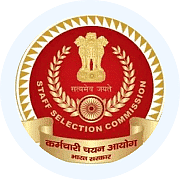Pushyabhuti Dynasty (Vardhana dynasty) | SSC CGL Tier 2 - Study Material, Online Tests, Previous Year PDF Download
The Pushyabhuti dynasty, alternatively recognized as the Vardhana dynasty, held a pivotal position in the historical narrative of North India, notably in the 6th and 7th centuries CE.
- Pushyabhuti/Vardhana dynasty: Noteworthy for contributions to Indian literature, culture, and religion during Emperor Harsha's era.
- Political influence declined, but legacy persisted through literary and cultural achievements, and support for scholars and artists.
- Prominent rulers: Prabhakaravardhana, Rajyavardhana, and the renowned Harsha.
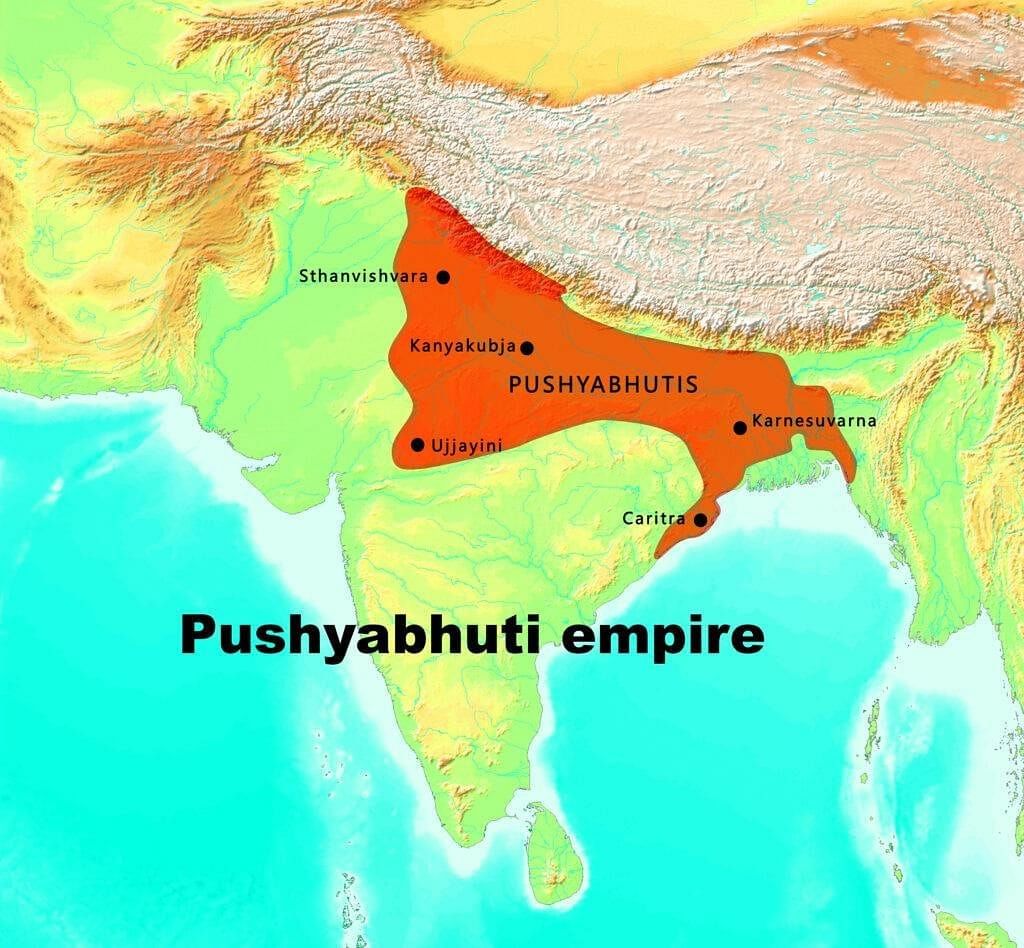
India in the 6th Century: Post-Gupta Era and Regional Shifts
- Gupta Empire Decline: Gupta rule weakened, contributing to the collapse of the political system in northern India.
- Absence of Alternative Empire: No viable successor empire emerged.
- Maukharis in Kosala/Kanyakubja: Established in modern Uttar Pradesh.
- Later Guptas in Magadha and Malwa: Ruled over modern Bihar and Madhya Pradesh.
- Pushyabhutis: Independent ruling group with uncertain origins.
- Eastern Kingdoms' Roles: Assam, Bengal, and Odisha played crucial roles in the power vacuum.
- Founder: King Shashanka established Gauda kingdom in late 6th century.
- Territorial Expansion: Gauda extended rule over northern and western regions of Bengal.
- Origins Uncertain: Lack of extensive documentation on the early ruler Pushyabhuti.
- Hiuen Tsang's Account: Chinese Buddhist monk-scholar Hiuen Tsang's 7th-century visit to India provides valuable insights into the Pushyabhutis.
- Time Period: Hiuen Tsang visited India in the 7th century (602-664 CE).
- Meeting with Harsha: Had a significant meeting with Harsha, offering insights into this transitional period in Indian history.
The Pushyabhuti or Vardhana Dynasty
The Pushyabhuti dynasty, originating in the region of Thanesar in present-day Haryana, India, succeeded the Gupta Empire in the Gangetic region, marking a significant era in Indian history.
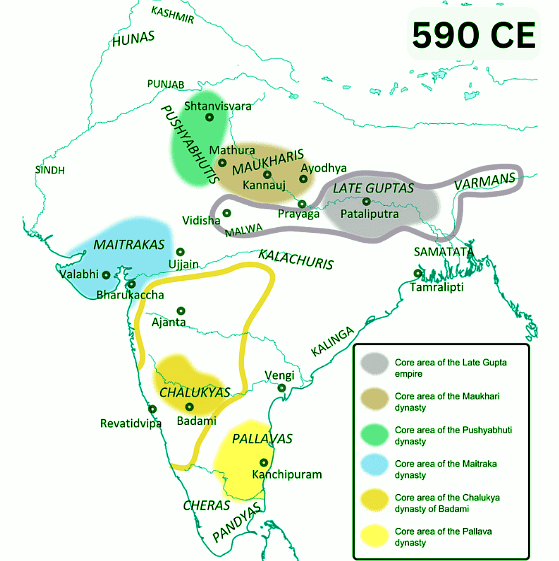
Rulers of the Pushyabhuti Dynasty

Administration and Military of the Pushyabhuti Dynasty
Administration
- Vast Empire and Administrative Framework:
- Extent of Rule: As the ruler of a vast empire covering northern and northwestern India, Harsha implemented a meticulous administrative framework.
- Hierarchical Administrative Structure:
- Structural Organization: Harsha's administration featured a hierarchical structure designed to handle the complexities of the expansive empire.
- Provincial Division: The empire was systematically divided into provinces or Bhuktis.
- Provincial Governance:
- Governance Structure: Each Bhukti was placed under the control of provincial officials or governors, known as Samantas.
- Local Governance at District and Village Levels:
- Subdivisions: Within the provinces, further subdivisions occurred at the district and village levels.
- Village Councils (Ganas): Local governance was facilitated through village councils known as Ganas.
- Role of Ganas in Local Administration:
- Maintenance of Law and Order: Ganas played a pivotal role in maintaining law and order at the grassroots level.
- Effective Administration: They ensured effective administration in the decentralized structure, contributing to the overall stability of Harsha's rule.
- Governance Philosophy and Efficient Rule:
- Harsha's Approach: Harsha's governance approach, characterized by a well-organized provincial division and reliance on local councils, demonstrated his commitment to managing the challenges posed by the vastness of his empire.
- Efficiency and Stability: The hierarchical administrative system enabled efficient governance and significantly contributed to the stability of Harsha's rule.
Military
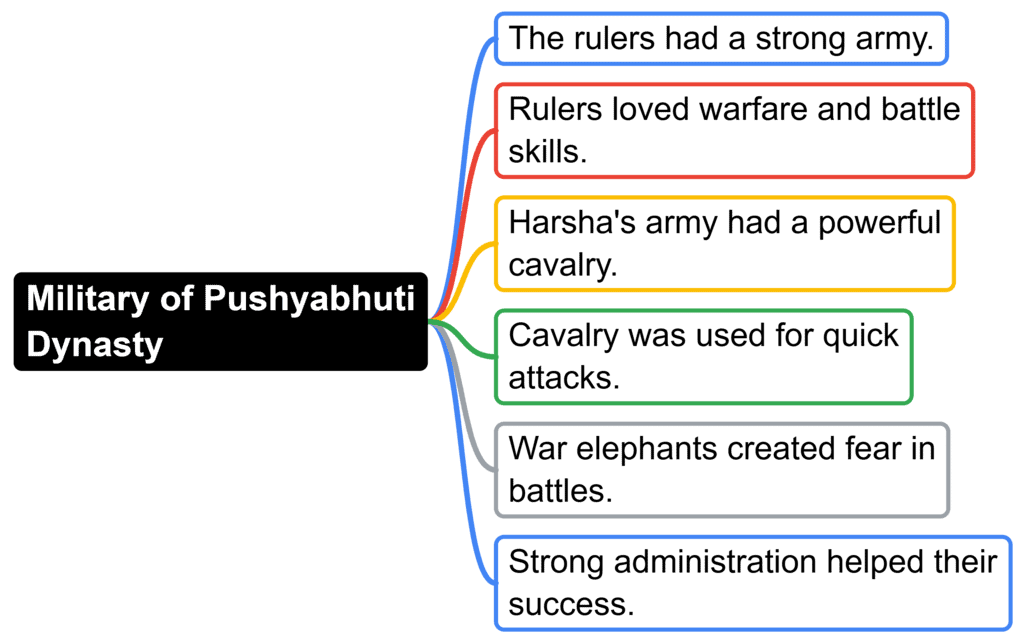
Culture and Religion of the Pushyabhuti Dynasty
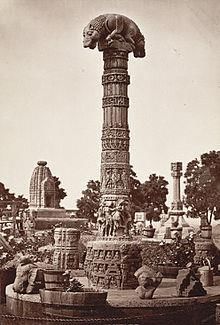
- Religious Transformation and Open-mindedness:
- Harsha's Spiritual Journey: Initially a follower of Shaivite Hinduism, Harsha underwent a significant religious transformation, adopting Buddhism.
- Religious Tolerance: Harsha's reign was marked by religious tolerance, actively supporting both Hinduism and Buddhism.
- Religious Assembly and Intellectual Contributions:
- Prayaga or Kanyakubja Assembly: Harsha organized a grand assembly that united Buddhists, Hindus, and Jains, showcasing his commitment to religious harmony.
- Scholarly Endeavors: As a scholar and author, Harsha wrote plays, including the renowned "Harshacharita" by poet Banabhatta, offering valuable insights into his life and rule.
- Promotion of Arts and Learning:
- Patron of the Arts: Harsha played a significant role as a patron of the arts, making substantial contributions to Nalanda University and supporting intellectuals and scholars.
- Cultural Flourishing: Poets like Bana flourished under Harsha's patronage, contributing to the cultural richness of the dynasty.

- Literary Contributions of Harsha:
- Playwright Endeavors: Harsha is credited with three plays – Priyadarshika, Ratnavali, and Nagananda, although there is debate about their authorship.
- Cultural Engagement: Regardless of authorship, these literary contributions underscore Harsha's interest in and impact on the cultural landscape.
Decline of the Pushyabhuti Dynasty
- Post-Harsha Period:
- Harsha's Death (647 CE): Following Harsha's death in 647 CE, the Pushyabhuti dynasty encountered internal conflicts and external invasions.
- Empire Fragmentation: These challenges led to the gradual fragmentation of the empire, marking the end of the Vardhana era.
- Rise of Regional Powers:
- End of Vardhana Era: The decline of the Pushyabhuti dynasty saw the rise of regional powers, signaling the end of the Vardhana era.
- Prominence of Regional Kingdoms: Regional powers gained prominence in the aftermath of the dynasty's decline.
- Continued Significance of Kanyakubja:
- Rule of Yashovarman (725-753 CE): Despite the dynasty's decline, Kanyakubja remained a significant kingdom under rulers like King Yashovarman.
- Center of Power: Yashovarman maintained Kanyakubja as a center of power, ensuring its continued significance.
- Symbol of Imperial Power:
- 750-1000 CE Period: Between 750 and 1000 CE, Kanyakubja became a symbol of imperial power.
- Influence on Distant States: Even distant states like the Rashtrakutas, Pratiharas, and Palas recognized and were influenced by the enduring legacy of the Pushyabhuti dynasty.
- Legacy of Pushyabhuti Dynasty:
- Lasting Influence: Despite the decline of the Pushyabhuti dynasty, its legacy endured through the influence of Kanyakubja on various states during the period between 750 and 1000 CE.
- Cultural and Political Impact: The dynasty's impact was not only political but also cultural, as reflected in Kanyakubja's enduring role as a symbol of imperial power.
|
1597 videos|1641 docs|920 tests
|
FAQs on Pushyabhuti Dynasty (Vardhana dynasty) - SSC CGL Tier 2 - Study Material, Online Tests, Previous Year
| 1. Who were the rulers of the Pushyabhuti Dynasty during the post-Gupta era in India? |  |
| 2. How was the administration of the Pushyabhuti Dynasty structured? |  |
| 3. What was the military strength of the Pushyabhuti Dynasty? |  |
| 4. What were the cultural and religious aspects associated with the Pushyabhuti Dynasty? |  |
| 5. How did the Pushyabhuti Dynasty decline? |  |




